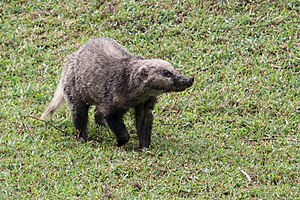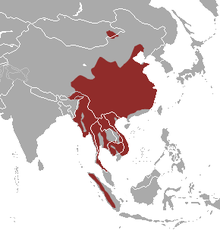Pig badger
| Pig badger | ||||||||||||
|---|---|---|---|---|---|---|---|---|---|---|---|---|

Pig badger ( Arctonyx collaris ) |
||||||||||||
| Systematics | ||||||||||||
|
||||||||||||
| Scientific name | ||||||||||||
| Arctonyx | ||||||||||||
| F. Cuvier , 1825 |
The pig badgers ( Arctonyx ) are a genus of predators from the subfamily of badgers (Melinae) within the family of marten (Mustelidae). They occur in three types in East and Southeast Asia.
features
In general, pig badgers resemble the badgers of the genus Meles to which the European badger also belongs, but differ in the narrow, elongated snout, which is formed into a pig-like , hairless trunk. The molars are smaller and further apart, the upper row of incisors is more curved and the bone capsule formed by the temporal bone, which surrounds parts of the middle and inner ear ( auditory bulla ), is flattened. The color of the fur on the back varies from gray-yellow to black, the belly is just as black as the feet. They have black stripes from the nose to the ears and the neck on the otherwise whitish face, the ears, the throat (black in Meles ) and the tail are also white . Another difference to the European badger lies in the greatly elongated, curved claws which, in contrast to this, are white. These animals reach a head body length of about 55 to 70 centimeters, a tail length of 12 to 17 centimeters and a weight of 7 to 14 kilograms.
The tooth formula is: I 3/3, C 1/1, P4 / 3, M 1/2 = 36.
distribution and habitat
Pig badgers live in East and Southeast Asia , their range extends from northern China and northeastern India to the Malay Peninsula and the island of Sumatra . Their habitat is primarily forests, both tropical rainforests and mountain forests up to an altitude of 3500 meters.
Way of life
Pig badgers are crepuscular or nocturnal; they spend the day in crevices or burrows they dug themselves. Little is known about their social behavior, they probably live solitary.
food
These animals are omnivores and, similar to pigs, rummage through the ground with their trunks in search of something to eat. They consume worms, insects, larvae and rodents as well as roots, mushrooms and fruits.
Reproduction
The mating takes place in May, due to a dormancy , it does not give birth until February or March, the actual gestation period should be around six weeks. The litter size is one to five. The young are weaned at four months and reach full size at eight months.
species
For a long time all pig badgers were called Arctonyx collaris . After a revision of the genus published in 2008, three species are recognized today:
- Northern pig badger ( Arctonyx albogularis )
- Pig badger ( Arctonyx collaris )
- Sumatran pig badger ( Arctonyx hoevenii )
Threats
The pig badger's natural enemies include tigers , leopards and other larger predators. Their defensive measures include the threatening erection of the hair and spraying of a foul-smelling secretion from the anal gland . If necessary, they also defend themselves with their long claws.
Human threats include hunting and habitat loss due to deforestation. Pig badgers, however, are not endangered species.
literature
- Ronald M. Nowak: Walker's Mammals of the World. 2 volumes. 6th edition. Johns Hopkins University Press, Baltimore MD et al. 1999, ISBN 0-8018-5789-9 .
supporting documents
- ↑ a b c d Serge Larivière & Andrew P. Jennings: Family Mustelidae (Weasels and relatives). in Don E. Wilson , Russell A. Mittermeier : Handbook of the Mammals of the World - Volume 1 Carnivores. Lynx Editions, 2009, ISBN 978-84-96553-49-1 . Page 622.
- ^ A b Kristofer M. Helgen, Norman T-Lon Lim, Lauren E. Helgen: The hog-badger is not an edentate: systematics and evolution of the genus Arctonyx (Mammalia: Mustelidae). Zoological Journal of the Linnean Society, Volume 154, Issue 2, October 2008, Pages 353-385, doi: 10.1111 / j.1096-3642.2008.00416.x . Page 361.
